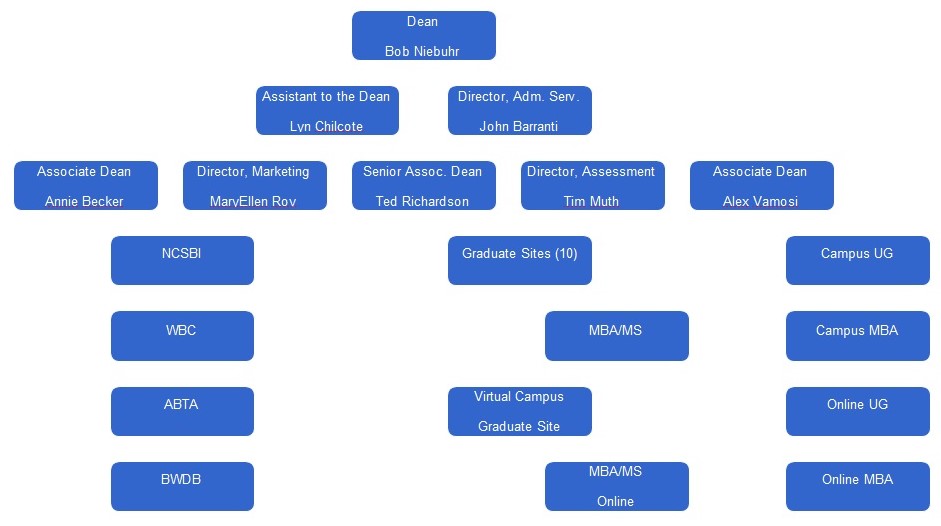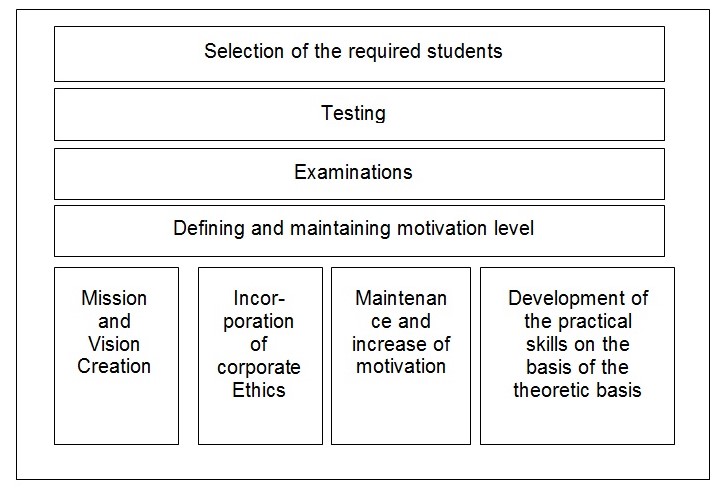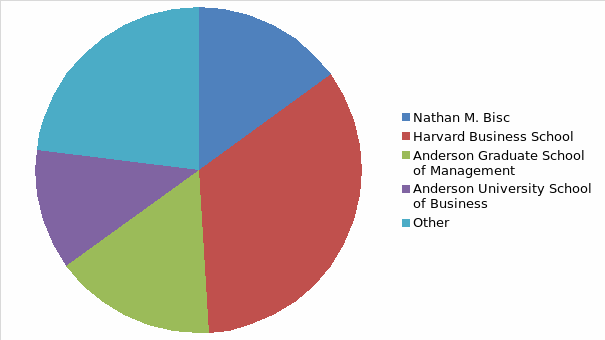Executive Summary
Marketing Nathan M. Bisk College of Business at Florida institute of technology is regarded as one of the most progressive and technologically advanced business colleges. It is one of the few colleges, which act in accordance with the marketing rules and business principles. The key events of the college development timeline are the instances of the cooperation extension. The college provides the all-round, high quality education, based on the world business experience, and pursues the aim to prepare the graduates for the variety of business professions, represented in the global business environment. Vision and mission of the college are regarded as the single, integrated element, which describes the main principles of the college activity. The value chain was based on the operating chart of the business college, as the existing amount of the departments and specifications requires thorough approach for the educational process in general, and the personnel selection in particular.
Historical Review
Originally, Florida Institute of Technology was founded in 1972 as the Florida Tech’s off-campus program. The representation of the program was arranged at the Patuxent River Naval Air Station in Maryland. Since that time, the company offers graduate and undergraduate programs, including business studies. Nathan M. Bisk is considered the founder of the business college, and, the necessity to offer the high quality educational business program originated the creation of the business college based on the innovative principles of work.
The key events of the college development timeline are the instances of the cooperation extension. Thus, the partners of the college, as it is stated by Moffatt (105) include “Orlando, Kennedy Space Center and Rockledge in Florida; Fort Lee, the National Capital Region and Hampton Roads and Norfolk Naval Station, all in Virginia.”
The current services of the business college entail the high quality educational business programs. Thus, in accordance with MaryEllen Roy – the Director of Marketing, Nathan M. Bisk College of Business, Florida Institute of Technology, the main concept entails the integrated marketing plans, the main aim of which is to give the students practical skills and deep theoretic representation on the matters of the strategic development, business planning, proper communication tools, etc. (Pierson, 67). In the light of this perspective, it should be emphasized that the target consumers of the business college are the students, who wish to get the perspective education, with the solid base for the further self-development.
Guiding Documents and Structure
Vision and mission of the college are regarded as the single, integrated element, which describes the main principles of the college activity. In the light of this consideration, there is strong necessity to emphasize that the college provides the all-round, high quality education, based on the world business experience, and pursues the aim to prepare the graduates for the variety of business professions, represented in the global business environment. (Scheele, 147)
Like any business organization, Nathan M. Bisk College can not deal without the codes of corporate ethics. Thus, ethical issues are represented in two aspects: set of codes for the internal (professional) activity within the teaching personnel, and the ethic issues, which are integrated into the curriculum. Thus, the aim of the curriculum is to make students familiar with the business ethics, and make them capable for ethical decision making and leadership challenges. (McKay, Kidwell, 105)
The documental basis is generally created for the employees knew the normative basis of their activity. The same should be emphasized on the maters of mission & vision, as well as the ethics. Moreover, these are the key principles of the educational process and the guidance rules for the personnel, consequently, not only employees should be aware of these documents, and the students of the college should be familiar with the key positions of these regulations.
Mission and Vision Statement
The statement of mission and vision is provided on the official web page of the institute:
The Nathan M. Bisk College of Business is an integral academic unit of Florida Institute of Technology. The college provides well-rounded, high quality educational experiences to prepare graduates for a variety of careers in the global business environment. In support of all undergraduate and graduate programs, the college(Florida Institute of Technology, 2010):
- Provides foundational knowledge in all areas of business and exposes students to ethical decision making and leadership challenges;
- Continuously improves curricula, being responsive to a rapidly changing global workforce;
- Furthers intellectual growth opportunities for both faculty and students;
- Serves society through quality educational offerings that target the needs of working professionals and traditional college students, encouraging a culturally diverse student experience; (Florida Institute of Technology, 2010)
Organization Charts

Students division is arranged in accordance with the principle of the motivation level. In spite of the fact that the motivation principles and practices are common within the entire university, different groups of students appear to be motivated differently. As it is emphasized by Cohen (167):
Talented and highly motivated professional with demonstrated success designing and launching effective marketing and promotional strategies to secure new client base and increase revenue, collaborate with cross-divisional colleagues, stakeholders, and consultants to facilitate communication and determine long-term goals.
Strategic Analysis
The value chain, which is relevant for the Nathan M. Bisk Business College is closely associated with the educational process and the process of selecting the participants of the educational programs. Thus, value chain entails the following components:

Personnel selection incorporates all the previously described elements, nevertheless, the necessity to adjust them to the HR principles have originated another components, which presupposes the constant personal and professional development of the personnel.
Originally, the value chain was based on the operating chart of the business college, as the existing amount of the departments and specifications requires thorough approach for the educational process in general, and the personnel selection in particular. Consequently, the chart and the value chain properly fit each other by the means of arranging the effective line of professional and educational activity.
As for the matters of performing all the actions of the value chain, it should be stated that the success of the educational and professional activity depends on these actions; consequently, the necessity to perform the entire value chain is obvious. The actions, which are associated with the psychological values of the students and personnel, are contracted out. The other actions are performed either by the personnel or by the students.
Supply distribution channel is entirely associated with the proper performance of the educational tasks and the matters of attracting the most talented and motivated students.
Macro-Environmental Forces
The macro-environmental forces, which generally rule the business activity of the Nathan M Bisk business college, depend on the aims of the organization, and the environmental factors, which define the issues and values of the business activity. Originally, the aims, and the corresponding environmental forces are the following:
- Market research – analysis of the business activity by the analysts.
- Cross-functional leadership – changing leadership premises.
- Marketing design – educational business environment
- Strategic and tactical planning – necessity to analyze the internal business activity
- Conversion
- Business development
- Sales growth
Thus, the entire industry is regulated by the environmental business factors, and the reaction of the business management department of the college on these factors.
SWOT
Thus, the coherent strategies, which are associated with the represented aspects of business college activity, should be aimed at the extension of the cooperation with business corporations and increase of the opportunities for the online students. (Brenner, Pringle, Greenhaus, 56)
Competitor Analysis
Originally, the market share of the Nathan M Bisk Business College is up to 5%, thus, placing it among the leaders of the business educational sphere. Nevertheless, the sales level growth is low. Originally, it is explained by the fact that students tend not to trust innovative technologies in the sphere of business education. The business share chart reveals the following data

Where:
The only difference is covered in the notion that Nathan M. Bisk Business college is the only, which resorts to business approach in its professional activity. Moreover, the business environment of this college appears to be even less favorable than for the others. (Karemera, Reuben, 298)
Sustainability Practices
The only sustainability practice that should be implemented into the professional activity of the college is the proper communication technologies. Originally, improper arrangement of the communication is the reason of the regarded weaknesses and threats (in the SWOT matrix). All the other processes, associated with analysis and development have been already implemented.
As for the matters of the financial sustainability, it should be emphasized that the college management has already implemented all the necessary practices, such as banking accounting and leasing practices of the necessary equipment.
Strategic Recommendations
The recommendations are the following:
- Extension of the cooperation with business structures
- Improvement of the communication strategies (including communication with online students)
- Deeper business analysis of the educational market
Originally, all the problems have been already discussed, and the possible problems, which may be found are closely associated with the improper communication and inability of the business management group to extend the cooperation with the business structures. (Swarthmore College Faculty, 12)
Appendix
Timeline of major events
Works Cited
Brenner, O.C., Charles D. Pringle, and Jeffrey H. Greenhaus. “Perceived Fulfillment of Organizational Employment versus Entrepreneurship: Work Values and Career Intentions of Business College Graduates.” Journal of Small Business Management 29.3 (2002): 62
Cohen, Audrey J. “Predictors of Public or Private Employment for Business College Graduates.” Public Personnel Management 22.1 (2004): 167
Florida Institute of Technology, “Mission Statement. Vision Statement” 2010. Web.
Karemera, David, Lucy J. Reuben, and Marion R. Sillah. “The Effects of Academic Environment and Background Characteristics on Student Satisfaction and Performance: The Case of South Carolina State University’s School of Business.” College Student Journal 37.2 (2003): 298
Luthy, Michael R., Barry L. Padgett, and Julie F. Toner. “In the Beginning: Ethical Perspectives of Business and Non-business College Freshmen.” Journal of Legal, Ethical and Regulatory Issues 12.2 (2009): 85
McKay, Ruth B., Linda A. Kidwell, and James A. Kling. “Faculty Ethics from the Perspective of College of Business Administrators.” Journal of Legal, Ethical and Regulatory Issues 10.1 (2007): 105
Moffatt, Michael. Coming of Age in New Jersey: College and American Culture. New Brunswick: Rutgers University Press, 2001.
Pierson, Frank C. The Education of American Businessmen: A Study of University-College Programs in Business Administration. New York: McGraw-Hill, 2002.
Scheele, Adele M. Launch Your Career in College: Strategies for Students, Educators, and Parents. Westport, CT: Praeger, 2005.
Swarthmore College Faculty. An Adventure in Education: Swarthmore College under Frank Aydelotte. New York: The Macmillan Company, 2000.
